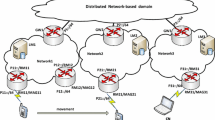Abstract
We have designed the heterogeneity inclusion and mobility adaptation through locator ID separation (HIMALIS) architecture to support mobility natively in the New Generation Network. This paper proposes a new distributed mobility scheme in the HIMALIS architecture for supporting seamless mobility for the host moving across access networks of different network-layer protocols. The proposed scheme also supports mobility of an access network. It includes a signaling procedure to redirect downstream traffic from the previous gateway (or previous access router) to the new gateway (or new access router) to minimize the service disruption or packet losses during a handover. The performance results obtained from a testbed implementation in Linux validate the effectiveness of the proposal. The results demonstrate that it can achieve seamless (no packet loss) handovers if overlapped wireless access networks are available.










Similar content being viewed by others
References
Kafle, V. P., Li, R., Tazaki, H., & Harai, H. (2012). Network mobility management in HIMALIS architecture of future networks. In Proceedings of workshop on mobility management in networks of the future world (MobiWorld’12), collocated with IEEE Globecom, Anaheim, CA, USA, Dec 2012.
Saltzer, J. (1993). On the naming and binding of network destinations, RFC 1498.
Kafle, V. P., & Inoue, M. (2010). HIMALIS: Heterogeneity inclusion and mobility adaptation through locator ID separation in new generation networks. IEICE Transactions on Communications, E93–B(3), 478–489.
Moskowitz, R., Nikander, P., Jokela, P., & Henderson, T. (2008). Host identity protocol, RFC 5201, IETF, Apr 2008.
Nordmark, E., & Bagnulo, M. (2009). Shim6: Level 3 multihoming shim protocol for IPv6, RFC 5533, IETF, June 2009.
Farinacci, D., Fuller, V., Meyer, D., & Lewis, D. (2013). Locator/ID separation protocol (LISP), RFC 6830, IETF, Jan 2013.
Kafle, V. P., & Inoue, M. (2010). Mobility management in HIMALIS architecture. In Proceedings of IEEE CCNC 2010, Jan 2010.
Kafle, V. P., Li, R., Inoue, D., & Harai, H. (2012). An integrated security scheme for ID/locator split architecture of future network. In Proceedings of FutureNet workshop (collocated with IEEE ICC’12), June 2012.
IEEE Std 802.11r-2008 (2008). IEEE Standard for local and metropolitan area networks—Part 11: Wireless and LAN Medium Access Control (MAC) and Physical Layer (PHY) Specifications, Ammendment 2: Fast Basic Service Set (BSS) Transition, IEEE Standards Association, July 2008.
IEEE Std 802.16-2009 (2009). IEEE standard for local and metropolitan area networks—Part 16: Air interface for fixed and mobile broadband wireless access systems, IEEE Standards Association, May 2009.
Perkins, C. (1996). IP mobility support, RFC 2002, Oct 1996.
Perkins, C., Johnson, D., & Arkko, J. (2011). Mobility support in IPv6, RFC 6275, IETF, July 2011.
Koodli, R. (2009). Mobile IPv6 fast handovers, RFC 5568, July 2009.
Soliman, H., Castellucia, C., ElMalki, K., & Belier, L. (2008). Hierarchical mobile IPv6 (HMIPv6) mobility management, RFC 5380, Oct 2008.
Gundavelli, S., Leung, K., Devarapalli, V., Chowdhury, K., & Patil, B. (2008). Proxy Mobile IP, RFC 5213 Aug 2008.
Devarapalli, V., Wakikawa, R., Petrescu, A., & Thubert, P. (2005). Network mobility (NEMO) basic support protocol, RFC 3963, IETF, Jan 2005.
Bertin, P., Bonjour, S., & Bonnin, J. (2009). Distrubuted or centralized mobility. In Proceedings of IEEE Globecom, Dec 2009.
Wakikawa, R., Valadon, G., & Murai, J. (2006). Migrating home agents towards Internet-scale mobility deployments. In ACM CoNEXT conference on future networking technologies, Dec 2006.
Liu, D., et al. (2013). Distrubuted mobility management: Current practices and gap analysis. In IETF Internet-Draft draft-ietf-dmm-best-practices-gap-analysis-01 (work-in-progress), June 2013.
Madson, C., & Glenn, R. (1998). The use of HMAC-SHA-1-96 within ESP and AH, RFC 2404, IETF, Nov 1998.
IEEE P802.11—Task Group ai. http://www.ieee802.org/11/Reports/tgai_update.htm. Accessed Apr 10 2013
Acknowledgments
The authors are grateful to Masugi Inoue, Kenji Fujikawa, Hajime Tazaki, Ruidong Li, Tomoji Tomuro, and Yasunaga Kobari for their valuable input to this research.
Author information
Authors and Affiliations
Corresponding author
Rights and permissions
About this article
Cite this article
Kafle, V.P., Fukushima, Y. & Harai, H. ID/Locator Split-Based Distributed Mobility Management Mechanism. Wireless Pers Commun 76, 693–712 (2014). https://doi.org/10.1007/s11277-014-1601-x
Published:
Issue Date:
DOI: https://doi.org/10.1007/s11277-014-1601-x




